|
|
|
Sort Order |
|
|
|
Items / Page
|
|
|
|
|
|
|
| Srl | Item |
| 1 |
ID:
103844
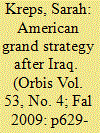

|
|
|
|
|
| Publication |
2009.
|
| Summary/Abstract |
To the extent that a grand strategy can be discerned in the first year of the Obama Administration, its defining features are not a break from the past but continuity. As the President himself has analogized since taking office, crafting grand strategy is like parallel parking. He has only been able to make changes to grand strategy around the margins since a number of existing commitments limit his freedom of action. This article first identifies the structural determinants of grand strategy, pointing to the international distribution of power, American bureaucracy, and public as the key sources of strategic constraint and opportunity. It then shows how shifts in these factors-comparatively less U.S. power, an overstretched military organized around counterinsurgency operations in Iraq and Afghanistan, and an American public weary from an aggressive grand strategy-produced a shift in grand strategy that predated the 2008 election and that remains consistent with the current strategic setting. It is for these reasons that the 2008 "change" election has produced considerable continuity in American grand strategy.
|
|
|
|
|
|
|
|
|
|
|
|
|
|
|
|
| 2 |
ID:
103843
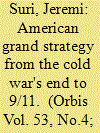

|
|
|
|
|
| Publication |
2009.
|
| Summary/Abstract |
Grand strategy is about making sense of complexity; it is the wisdom to make power serve useful purposes. After the end of the Cold War, American policymakers sought to create a new grand strategy for the United States, but they failed in this endeavor. They failed because of difficult domestic and international circumstances. They also failed because of conceptual limitations. This article traces the efforts at strategy formulation in the administrations of George H. W. Bush and Bill Clinton, and it analyzes their shortcomings. Bush had process without purpose; Clinton had purpose without process. The article encourages readers to think about how future strategists might improve upon this legacy with clearer and more disciplined attention to priorities, capabilities, and trade-offs. Making grand strategy in a democracy is not easy, but it is necessary. The absence of effective grand strategy in the 1990s contributed to the crises of the early twenty-first century.
|
|
|
|
|
|
|
|
|
|
|
|
|
|
|
|
| 3 |
ID:
103847
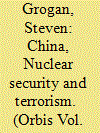

|
|
|
|
|
| Publication |
2009.
|
| Summary/Abstract |
This article outlines Chinese strategic nuclear forces and the Chinese philosophical approach to nuclear security. It then focuses on the domestic conditions in China which could precipitate vulnerabilities to its nuclear forces. From information about internal security conditions in China, specific internal threats to Chinese nuclear security will be derived. Based on these threats, several outsider and insider scenarios will be outlined involving a variety of terrorist or terrorist related behaviors. These notional scenarios will include everything from overrun or attack, to diversion, to cyber terrorism, to sabotage. The article will then cover what these scenarios and the possible Chinese reaction to them may mean for the security, military and diplomatic strategies of the United States
|
|
|
|
|
|
|
|
|
|
|
|
|
|
|
|
| 4 |
ID:
103846
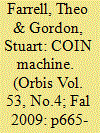

|
|
|
|
|
| Publication |
2009.
|
| Summary/Abstract |
This article assesses the British military effort in Afghanistan looking at three key elements in the campaign: strategy, military operations, and the inter-agency "Comprehensive Approach." We start by recognising the scale of the challenge that has faced the British: of all the provinces in Afghanistan, Helmand is the toughest to stabilize and secure. We then examine the evolution of all three elements above and find significant improvements in each: a flawed strategy has been corrected; the military have received more resources and become significantly better at COIN; and there is significant progress in the development of the inter-agency approach. In short, what the Americans will find in Helmand is a British COIN machine; a little creaky perhaps, but one that is fit for purpose and getting the job done. We briefly conclude on the prospects and the key to success: namely the development of a more coherent international strategy that accommodates the challenges posed by both Afghanistan and Pakistan.
|
|
|
|
|
|
|
|
|
|
|
|
|
|
|
|
| 5 |
ID:
103839


|
|
|
| 6 |
ID:
103842


|
|
|
|
|
| Publication |
2009.
|
| Summary/Abstract |
The perceived history of the Vietnam War profoundly influenced American discussions on grand strategy during the postwar period. The two largest schools of thought, one favoring confrontation with the Soviet Union and the other favoring engagement, drew lessons from the war based upon differing historical interpretations and used those lessons as support beams in constructing grand strategy. Compelling world events during the Carter presidency caused only a few individuals to shift positions in the debate, but one of those individuals was Jimmy Carter himself. Subsequent discoveries by historians indicate that the confrontation school understood the war's history and the postwar world better than did the engagement school and consequently crafted a superior grand strategy. The post-Vietnam debate contains numerous parallels to present-day discussions of grand strategy and offers a variety of lessons salient to contemporary strategic formulation.
|
|
|
|
|
|
|
|
|
|
|
|
|
|
|
|
| 7 |
ID:
103845
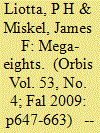

|
|
|
|
|
| Publication |
2009.
|
| Summary/Abstract |
By 2015, there will be 58 cities on the planet with a population of 5 million or more and, by 2025, according to National Intelligence Council, 27 cities with a population exceeding 10 million. The U.N. Population Division classifies populations in excess of 10 million as megacities and many of these urban behemoths will be located in the so-called 10/40 window-the area in Africa and Asia between north latitude 10 and 40 degrees. This emerging growth will have serious consequences for international stability, human security and environmental degradation. Without a doubt, unchecked growth in the 10/40 window will change the face of the global map in the twenty-first century. The questions are: how and what should be done about it? In this article, we primarily address the how question-leaving a detailed examination of policy options to others, as we contend that the most important step at this point in time is to first understand the nature of the problem.
|
|
|
|
|
|
|
|
|
|
|
|
|
|
|
|
| 8 |
ID:
103841


|
|
|
|
|
| Publication |
2009.
|
| Summary/Abstract |
This article examines the reassessment of U.S. strategy that Dwight D. Eisenhower directed after replacing Harry S. Truman in the White House in January 1953, as he worked to bring the Korean War to an end and then confronted the problems remaining in its aftermath. Despite much of the rhetoric of the early Eisenhower administration, the outcome of that reassessment fit more closely the objective of containment than key strategic formulations of its predecessor. Why was this so? How did the orientation apply to ending the war in Korea and sustaining the U.S. position there and elsewhere after the armistice? What insights, if any, do the process of reassessment and its outcome provide for the present? Answers to these questions serve to emphasize the dynamic and contingent nature of American strategy in the early Cold War and the importance of flexible, engaged leadership in the White House.
|
|
|
|
|
|
|
|
|
|
|
|
|
|
|
|
| 9 |
ID:
103840
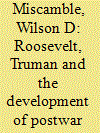

|
|
|
|
|
| Publication |
2009.
|
| Summary/Abstract |
After its victory in World War II, it was clear that United States should move beyond the disastrous policies of the 1930s, but it was less clear how. Ultimately, a lasting postwar strategy was forged under President Truman. Appreciating how Truman moved well beyond Roosevelt's guiding assumptions is essential to understanding the evolution of American grand strategy. One sees that wartime planning and grand strategy formulation can prove quite inadequate for dealing with postwar challenges. An administration cannot be locked into assumptions, but must constantly test them. Thus, the Truman administration eventually developed and adopted containment and moved far beyond FDR's approach. More substantively, the fundamental geopolitical lesson of World War II and the early Cold War was that the United States must assume the essential balancing role relative to other major powers.
|
|
|
|
|
|
|
|
|
|
|
|
|
|
|
|
|
|
|
|
|